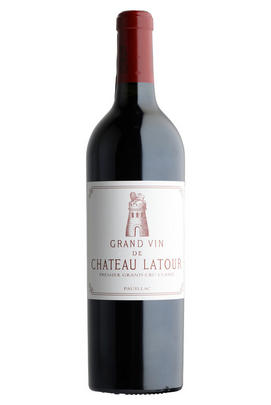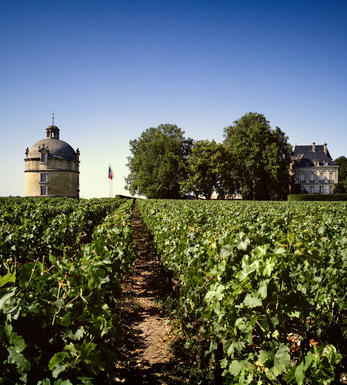
2011 Château Latour, Pauillac, Bordeaux

Critics reviews
The 2011 Latour is well-defined on the nose with blackberry, bilberry, cedar, hoisin and a touch of mint. There is impressive intensity here, regal and convincing. The palate is medium-bodied with grippy tannins. There is a solid backbone to this wine, plenty of freshness, quite powerful towards the finish with superb persistence. Wonderful. Tasted blind at the annual 10-Year-On tasting.
Drink 2022 - 2050
Neal Martin, Vinous.com (April 2022)
Tasted blind. Very deep crimson. Lighter nose than some – more high-toned. Rich and dense, this wine really grew in the mouth. But tannins were lighter than in some. Attractive savoury finish.
Drink 2018 - 2035
Jancis Robinson MW, JancisRobinson.com (October 2021)
A blend of 84.5% Cabernet Sauvignon, 15% Merlot and 0.5% Petit Verdot, the 2011 Latour represents only 34% of the crop. It hit 13.1% natural alcohol.
One of the vintage's most compelling wines, it possesses a dense ruby/purple color as well as a sweet, open-knit personality with ripe tannin, superb intensity, good purity and harmony, a medium to full-bodied mouthfeel, and lots of crushed rock, floral and black as well as blue fruit notes in addition to hints of ink and forest floor. This beautifully rich, savory Latour will be surprisingly drinkable in 4-5 years, and should age easily for two decades or more.
Drink 2016 - 2036
Robert M. Parker, Jr., Wine Advocate (April 2012)
Latour is all silk and velvet, with a gorgeous mouthfeel as the wine sails along, with cassis, cherry eau de vie and freshly sliced plum flavours, with a deeply ingrained iron note that adds considerable length to the finish.
James Molesworth, Wine Spectator (April 2012)
The nose is complex, featuring smoke, meat and hints of wood, with currants, olives and berries underneath. Full body with super-velvety tannins. The strong acidity gives the wine an edginess. Love the spicy, subtly fruity finish. Steely.
Try in 2020
James Suckling, JamesSuckling.com (January 2014)
Harvest September 12 to 26.
A delicious wine that stands out from many in the vintage. A ton of personality, with a sappy, raspberry, autumnal berry fruit as it opens and travels through the palate, with rose petals on the edge that give a beautiful uplift along with the classic trace of mint. Its tannins are a little more angular than you find in the 2010 and 2009, but it is starting to lengthen and open, although this was a vintage that was not immediately impressive in the way that the previous two had been. A stately Latour, one that needs another few years to really show its place. The last Latour to be sold en primeur in the old system. 34% of overall production.
Drink 2021 - 2048
Jane Anson, Decanter.com (February 2021)
About this WINE

Château Latour
Château Latour is a wine estate in Pauillac, part of the Haut-Medoc sub-region on the Left Bank of Bordeaux. The estate’s history dates back to at least the 14th century, though vineyards were not established here until the 17th century. The estate is located at the southern edge of the Pauillac appellation, bordering the St Julien vineyards of Château Léoville Las Cases. Latour is one of the five First Growths of the 1855 classification, occupying the top tier alongside Châteaux Lafite Rothschild, Margaux, Haut-Brion, and Mouton Rothschild.
Latour is owned by François Pinault, one of France’s wealthiest people. It forms the jewel in the crown of Pinault’s Artémis Domaines, itself part of the larger Groupe Artémis. Other wineries within the portfolio include Clos de Tart and Domaine d’Eugénie in Burgundy; Château Grillet in the Rhône Valley; Champagne Jacquesson; Eisele Vineyard in California’s Napa Valley; and Maisons et Domaines Henriot, which includes holdings in Champagne, Burgundy, and Oregon.
The day-to-day running of Latour is entrusted to the dynamic Frédéric Engerer. Under his stewardship, a major programme of investment has taken place. In 2012, Latour announced that it would no longer offer its wines as part of the Bordeaux En Primeur campaign. Instead, the wines are kept at the estate until such a time as they are ready to be opened and enjoyed. They are then offered through the La Place de Bordeaux distribution system several years after the vintage.
There are three wines produced here. Château Latour, the grand vin, is produced from vines immediately surrounding the château, from the vineyard area known as L’Enclos. Les Forts de Latour, the second wine, was created in 1966. It is now regarded as a great wine in its own right, certainly worthy of Classified Growth status. A third wine, Pauillac de Latour, is usually the product of young vines.
The vineyard is planted to a majority of Cabernet Sauvignon, along with some Merlot and small amounts of Cabernet Franc and Petit Verdot.

Pauillac
Pauillac is the aristocrat of the Médoc boasting boasting 75 percent of the region’s First Growths and with Grand Cru Classés representing 84 percent of Pauillac's production.
For a small town, surrounded by so many familiar and regal names, Pauillac imparts a slightly seedy impression. There are no grand hotels or restaurants – with the honourable exception of the establishments owned by Jean-Michel Cazes – rather a small port and yacht harbour, and a dominant petrochemical plant.
Yet outside the town, , there is arguably the greatest concentration of fabulous vineyards throughout all Bordeaux, including three of the five First Growths. Bordering St Estèphe to the north and St Julien to the south, Pauillac has fine, deep gravel soils with important iron and marl deposits, and a subtle, softly-rolling landscape, cut by a series of small streams running into the Gironde. The vineyards are located on two gravel-rich plateaux, one to the northwest of the town of Pauillac and the other to the south, with the vines reaching a greater depth than anywhere else in the Médoc.
Pauillac's first growths each have their own unique characteristics; Lafite Rothschild, tucked in the northern part of Pauillac on the St Estèphe border, produces Pauillac's most aromatically complex and subtly-flavoured wine. Mouton Rothschild's vineyards lie on a well-drained gravel ridge and - with its high percentage of Cabernet Sauvignon - can produce (in its best years) Pauillac's most decadently rich, fleshy and exotic wine.
Latour, arguably Bordeaux's most consistent First Growth, is located in southern Pauillac next to St Julien. Its soil is gravel-rich with superb drainage, and Latour's vines penetrate as far as five metres into the soil. It produces perhaps the most long-lived wines of the Médoc.
Recommended Châteaux
Ch. Lafite-Rothschild, Ch. Latour, Ch. Mouton-Rothschild, Ch. Pichon-Longueville Baron, Ch. Pichon Longueville Comtesse de Lalande, Ch. Lynch-Bages, Ch. Grand-Puy-Lacoste, Ch, Pontet-Canet, Les Forts de Latour, Ch. Haut-Batailley, Ch. Batailley, Ch. Haut-Bages Libéral.

Cabernet Sauvignon Blend
Cabernet Sauvignon lends itself particularly well in blends with Merlot. This is actually the archetypal Bordeaux blend, though in different proportions in the sub-regions and sometimes topped up with Cabernet Franc, Malbec, and Petit Verdot.
In the Médoc and Graves the percentage of Cabernet Sauvignon in the blend can range from 95% (Mouton-Rothschild) to as low as 40%. It is particularly suited to the dry, warm, free- draining, gravel-rich soils and is responsible for the redolent cassis characteristics as well as the depth of colour, tannic structure and pronounced acidity of Médoc wines. However 100% Cabernet Sauvignon wines can be slightly hollow-tasting in the middle palate and Merlot with its generous, fleshy fruit flavours acts as a perfect foil by filling in this cavity.
In St-Emilion and Pomerol, the blends are Merlot dominated as Cabernet Sauvignon can struggle to ripen there - when it is included, it adds structure and body to the wine. Sassicaia is the most famous Bordeaux blend in Italy and has spawned many imitations, whereby the blend is now firmly established in the New World and particularly in California and Australia.


Buying options
Add to wishlist
Description
Harvest September 12 to 26.
A delicious wine that stands out from many in the vintage. A ton of personality, with a sappy, raspberry, autumnal berry fruit as it opens and travels through the palate, with rose petals on the edge that give a beautiful uplift along with the classic trace of mint. Its tannins are a little more angular than you find in the 2010 and 2009, but it is starting to lengthen and open, although this was a vintage that was not immediately impressive in the way that the previous two had been. A stately Latour, one that needs another few years to really show its place. The last Latour to be sold en primeur in the old system. 34% of overall production.
Drink 2021 - 2048
Jane Anson, Decanter.com (February 2021)
wine at a glance
Delivery and quality guarantee